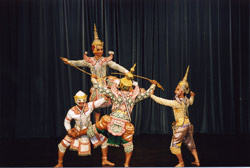 The culture of Cambodia has had a rich and varied history dating back many centuries, and has been heavily influenced by India and China.[1] Throughout Cambodia's long history, a major source of inspiration was from religion. Throughout nearly two millennium, Cambodians developed a unique Khmer belief from the syncreticism of indigenous animistic beliefs and the Indian religions of Buddhism and Hinduism. Indian culture and civilization, including its language and arts reached mainland Southeast Asia around the 1st century A.D. It is generally believed that seafaring merchants brought Indian customs and culture to ports along the Gulf of Thailand and the Pacific while trading with China. The first state to benefit from this was Funan.
The culture of Cambodia has had a rich and varied history dating back many centuries, and has been heavily influenced by India and China.[1] Throughout Cambodia's long history, a major source of inspiration was from religion. Throughout nearly two millennium, Cambodians developed a unique Khmer belief from the syncreticism of indigenous animistic beliefs and the Indian religions of Buddhism and Hinduism. Indian culture and civilization, including its language and arts reached mainland Southeast Asia around the 1st century A.D. It is generally believed that seafaring merchants brought Indian customs and culture to ports along the Gulf of Thailand and the Pacific while trading with China. The first state to benefit from this was Funan.
History
The golden age of Cambodia was between the 9th and 14th century, during the Angkor period, during which it was a powerful and prosperous empire that flourished and dominated almost all of inland south east Asia. However, Angkor would eventually collapse after much in-fighting between royalty and constant warring with its increasingly powerful neighbors, notably Siam and Dai Viet. Many temples from this period however, like Bayon and Angkor Wat still remain today, scattered throughout Thailand, Cambodia, Laos, and Vietnam as a reminder of the grandeur of Khmer arts and culture. Cambodia's unparalleled achievements in art, architectures, music, and dance during this period have had a great influence on many neighboring kingdoms, namely Thailand and Laos. The affect of Angkorian culture can still be seen today in those countries, as they share many close characteristics with current-day Cambodia.
Architecture and housing
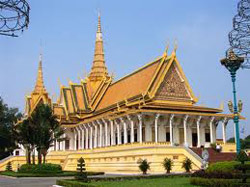
The Angkorian architects and sculptors created temples that mapped the cosmic world in stone. Khmer decorations drew inspiration from religion, and mythical creatures from Hinduism and Buddhism were carved on walls. Temples were built in accordance to the rule of ancient Khmer architecture that dictated that a basic temple layout include a central shrine, a courtyard, an enclosing wall, and a moat. Khmer motifs use many creatures from Buddhist and Hindu mythology, like the Royal Palace in Phnom Penh, use motifs such as the garuda, a mythical bird in Hinduism. The architecture of Cambodia developed in stages under the Khmer empire from the 9th to the 15th century, preserved in many buildings of the Angkor temple. The remains of secular architecture from this time are rare, as only religious buildings were made of stone. The architecture of the Angkor period used specific structural features and styles, which are one of the main methods used to date the temples, along with inscriptions.
Angkor Wat, The most Cambodian famous heritage.
In modern rural Cambodia, the nuclear family typically lives in a rectangular house that may vary in size from four by six meters to six by ten meters. It is constructed of a wooden frame with gabled thatch roof and walls of woven bamboo. Khmer houses are typically raised as much as three meters on stilts for protection from annual floods. Two ladders or wooden staircases provide access to the house. The steep thatch roof overhanging the house walls protects the interior from rain. Typically a house contains three rooms separated by partitions of woven bamboo. The front room serves as a living room used to receive visitors, the next room is the parents' bedroom, and the third is for unmarried daughters. Sons sleep anywhere they can find space. Family members and neighbors work together to build the house, and a house-raising ceremony is held upon its completion. The houses of poorer persons may contain only a single large room. Food is prepared in a separate kitchen located near the house but usually behind it. Toilet facilities consist of simple pits in the ground, located away from the house, that are covered up when filled. Any livestock is kept below the house. Chinese and Vietnamese houses in Cambodian towns and villages are typically built directly on the ground and have earthen, cement, or tile floors, depending upon the economic status of the owner. Urban housing and commercial buildings may be of brick, masonry, or wood.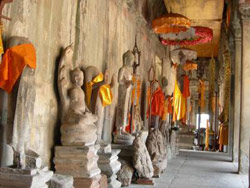
Religion
Cambodia is predominantly Buddhist with 90% of the population being Theravada Buddhist, 1% Christian and the majority of the remaining population follow Islam, atheism, or animism.
Buddhism has existed in Cambodia since at least the 5th century CE. Theravada Buddhism has been the Cambodian state religion since the 13th century CE (excepting the Khmer Rouge period), and is currently estimated to be the faith of 90% of the population.
Islam is the religion of a majority of the Cham (also called Khmer Islam) and Malay minorities in Cambodia. According to Po Dharma, there were 150,000 to 200,000 Muslims in Cambodia as late as 1975. Persecution under the Khmer Rouge eroded their numbers, however, and by the late 1980s they probably had not regained their former strength. All of the Cham Muslims are Sunnis of the Shafi'i school. Po Dharma divides the Muslim Cham in Cambodia into a traditionalist branch and an orthodox branch.
Christianity was introduced into Cambodia by Roman Catholic missionaries in 1660. However, it made little headway at first, particularly among Buddhists. In 1972 there were probably about 20,000 Christians in Cambodia, most of whom were Roman Catholics. According to Vatican statistics, in 1953, members of the Roman Catholic Church in Cambodia numbered 120,000, making it, at that time, the second largest religion in the country. In April 1970, just before repatriation, estimates indicate that about 50,000 Catholics were Vietnamese. Many of the Catholics remaining in Cambodia in 1972 were Europeans—chiefly French. American Protestant missionary activity increased in Cambodia, especially among some of the hill tribes and among the Cham, after the establishment of the Khmer Republic. The 1962 census, which reported 2,000 Protestants in Cambodia, remains the most recent statistic for the group. Observers reported that in 1980 there were more registered Khmer Christians among the refugees in camps in Thailand than in all of Cambodia before 1970. Kiernan notes that, until June 1980, five weekly Protestant services were held in Phnom Penh by a Khmer pastor, but that they had been reduced to a single weekly service after police harassment. There are around 20,000 Catholics in Cambodia which represents only 0.15% of the total population. There are no dioceses, but there are three territorial jurisdictions - one Apostolic Vicariate and two Apostolic Prefectures.
Highland tribal groups, most with their own local religious systems, probably number fewer than 100,000 persons. The Khmer Loeu have been loosely described as animists, but most tribal groups have their own pantheon of local spirits. In general they see their world filled with various invisible spirits (often called yang), some benevolent, others malevolent. They associate spirits with rice, soil, water, fire, stones, paths, and so forth. Sorcerers or specialists in each village contact these spirits and prescribe ways to appease them. In times of crisis or change, animal sacrifices may be made to placate the anger of the spirits. Illness is often believed to be caused by evil spirits or sorcerers. Some tribes have special medicine men or shamans who treat the sick. In addition to belief in spirits, villagers believe in taboos on many objects or practices. Among the Khmer Loeu, the Rhade and Jarai groups have a well developed hierarchy of spirits with a supreme ruler at its head.
Ways of life
Birth and death rituals
The birth of a child is a happy event for the family. According to traditional beliefs, however, confinement and childbirth expose the family, and especially the mother and the child to harm from the spirit world. A woman who dies in childbirth—crosses the river (chhlong tonle) in Khmer is believed to become an evil spirit. In traditional Khmer society, a pregnant woman respects a number of food taboos and avoids certain situations. These traditions remain in practice in rural Cambodia, but they have become weakened in urban areas.
Death is not viewed with the great outpouring of grief common to Western society; it is viewed as the end of one life and as the beginning of another life that one hopes will be better. Buddhist Khmer usually are cremated, and their ashes are deposited in a stupa in the temple compound. A corpse is washed, dressed, and placed in a coffin, which may be decorated with flowers and with a photograph of the deceased. White pennant-shaped flags, called "white crocodile flags," outside a house indicate that someone in that household has died. A funeral procession consisting of an achar, Buddhist monks, members of the family, and other mourners accompanies the coffin to the crematorium. The spouse and the children show mourning by shaving their heads and by wearing white clothing. Relics such as teeth or pieces of bone are prized by the survivors, and they are often worn on gold chains as amulets. If the child is always ill, his or her parents can go and change the name of child
Childhood and adolescence
A Cambodian child may be nursed until he or she is between two and four years of age. Up to the age of three or four, the child is given considerable physical affection and freedom. Children around five years of age also may be expected to help look after younger siblings. Children's games emphasize socialization or skill rather than winning and losing.
Most children begin school when they are seven or eight. By the time they reach this age, they are familiar with the society's norms of politeness, obedience, and respect toward their elders and toward Buddhist monks. The father at this time begins his permanent retreat into a relatively remote, authoritarian role. By age ten, a girl is expected to help her mother in basic household tasks; a boy knows how to care for the family's livestock and can do farm work under the supervision of older males. Adolescent children usually play with members of the same sex. During his teens, a boy may become a temple servant and go on to serve a time as a novice monk, which is a great honor for the parents.
In precommunist days, parents exerted complete authority over their children until the children were married, and the parents continued to maintain some control well into the marriage. Age difference is strictly recognized with polite vocabulary and special generational terms for "you".
It is acceptable for a mother or caretaker in Cambodia, especially those from rural areas, to kiss the penis of an infant or put it in her mouth as a sign of respect or love. The child is usually 1 year old or younger, “but no more than 2 years old,” he said. The act has nothing to do with sexual feelings, he said, noting that it can be viewed as a sign of high respect by a caretaker for a future “master.” The act is not part of the general culture, it is an exception.
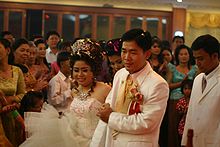
In Cambodia, premarital sex is deplored. The choice of a spouse is a complex one for the young male, and it may involve not only his parents and his friends, as well as those of the young woman, but also a matchmaker. In theory, a girl may veto the spouse her parents have chosen. Courtship patterns differ between rural and urban Khmer; romantic love is a notion that exists to a much greater extent in larger cities. A man usually marries between the ages of nineteen and twenty-five, a girl between the ages of sixteen and twenty-two. After a spouse has been selected, each family investigates the other to make sure its child is marrying into a good family. In rural areas, there is a form of bride-service; that is, the young man may take a vow to serve his prospective father-in-law for a period of time.
Bride and groom at a Cambodian wedding
The traditional wedding is a long and colorful affair. Formerly it lasted three days, but in the 1980s it more commonly lasted a day and a half. Buddhist priests offer a short sermon and recite prayers of blessing. Parts of the ceremony involve ritual hair cutting, tying cotton threads soaked in holy water around the bride's and groom's wrists, and passing a candle around a circle of happily married and respected couples to bless the union. After the wedding, a banquet is held. Newlyweds traditionally move in with the wife's parents and may live with them up to a year, until they can build a new house nearby.
Divorce is legal and relatively easy to obtain, but not common. Divorced persons are viewed with some disapproval. Each spouse retains whatever property he or she brought into the marriage, and jointly-acquired property is divided equally. Divorced persons may remarry, but the woman must wait ten months. Custody of minor children is usually given to the mother, and both parents continue to have an obligation to contribute financially toward the rearing and education of the child.
Social organization
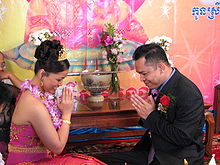 Khmer culture is very hierarchical. The greater a person's age, the greater the level of respect that must be granted to them. Cambodians are addressed with a hierarchical title corresponding to their seniority before the name. When a married couple becomes too old to support themselves, they may invite the youngest child's family to move in and to take over running the household. At this stage in their lives, they enjoy a position of high status.
Khmer culture is very hierarchical. The greater a person's age, the greater the level of respect that must be granted to them. Cambodians are addressed with a hierarchical title corresponding to their seniority before the name. When a married couple becomes too old to support themselves, they may invite the youngest child's family to move in and to take over running the household. At this stage in their lives, they enjoy a position of high status.The individual Khmer is surrounded by a small inner circle of family and friends who constitute his or her closest associates, those he would approach first for help. The nuclear family, consisting of a husband and a wife and their unmarried children, is the most important kin group. Within this unit are the strongest emotional ties, the assurance of aid in the event of trouble, economic cooperation in labor, sharing of produce and income, and contribution as a unit to ceremonial obligations. In rural communities, neighbors—who are often also kin—may be important, too. Fictive child-parent, sibling, and close friend relationships Cambodia transcend kinship boundaries and serve to strengthen interpersonal and interfamily ties. Beyond this close circle are more distant relatives and casual friends. In rural Cambodia, the strongest ties a Khmer may develop—besides those to the nuclear family and to close friends—are those to other members of the local community. A strong feeling of pride—for the village, for the district, and province—usually characterizes Cambodian community life.
Legally, the husband is the head of the Khmer family, but the wife has considerable authority, especially in family economics. The husband is responsible for providing shelter and food for his family; the wife is generally in charge of the family budget, and she serves as the major ethical and religious model for the children, especially the daughters. Both husbands and wives are responsible for domestic economic tasks.
Customs
When greeting people or to show respect in Cambodia people do the "sampeah" gesture, identical to the Indian namaste and Thai wai.
Clothing
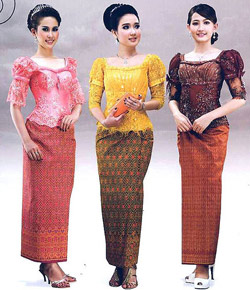 Clothing in Cambodia is one of the most important aspects of the culture. Cambodian fashion is divided by the people's differing castes and social classes. Cambodians traditionally wear a checkered scarf called a "Krama". The "krama" is what distinctly separates the Khmer (Cambodians) from their neighbors the Thai, the Vietnamese, and the Laotians. The scarf is used for many purposes including for style, protection from the sun, an aid (for your feet) when climbing trees, a hammock for infants, a towel, or as a "sarong". A "krama" can also be easily shaped into a small child's doll for play. Under the Khmer Rouge, krama of various patterns were part of standard clothing.
Clothing in Cambodia is one of the most important aspects of the culture. Cambodian fashion is divided by the people's differing castes and social classes. Cambodians traditionally wear a checkered scarf called a "Krama". The "krama" is what distinctly separates the Khmer (Cambodians) from their neighbors the Thai, the Vietnamese, and the Laotians. The scarf is used for many purposes including for style, protection from the sun, an aid (for your feet) when climbing trees, a hammock for infants, a towel, or as a "sarong". A "krama" can also be easily shaped into a small child's doll for play. Under the Khmer Rouge, krama of various patterns were part of standard clothing.
Cuisine
 |
| Amok, a popular Cambodian dish |
Arts and literature
Visual artMusic
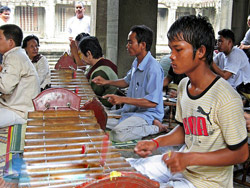 |
|
Roneat has been described as a bamboo xylophone. |
Especially in the 60s and 70s, the 'big two' duet of Sinn Sisamouth and Ros sereysothea had been a large hit in the country. However after their deaths, new music stars have tried to bring back the music. Cambodian music has undergone heavy westernization.
Dance
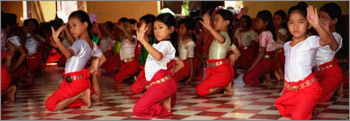 Khmer classical dance is a form of Cambodian dance originally performed only for royalty. The dances have many elements in common with Thai classical dance. During the mid-20th century, it was introduced to the public where it now remains a celebrated icon of Khmer culture, often being performed during public events, holidays, and for tourists visiting Cambodia. This classical Dance is famous for its using of hands and feet to express emotion which known as there are 4,000 different gestures in this type of dance. Provided as repeating a golden age in 1960s, Khmer Classical Dance which know as The Royal Ballet of Cambodia after select as UNESCO’s Masterpieces of the Oral and Intangible Heritage of Humanity, has lead one of its dance to be a outstanding dance of all for culture and society. Reamker, a khmer version of Indian, Ramayana had influced strongly to Khmer classical dance. It involved in khmer gesture, movement and story line.The dance that divided from Reamker Dance known as robam sovann macha and robam moni mekala. In Facts, all of Dance reminded the audience of celestial dance which is an angel or Apsara in sansrit mythology in goal of bring the good luck and success to the viewer. The Classical dance is create by the heart of high art as the performer is decorated with themselves with a branches of jewellry.
Khmer classical dance is a form of Cambodian dance originally performed only for royalty. The dances have many elements in common with Thai classical dance. During the mid-20th century, it was introduced to the public where it now remains a celebrated icon of Khmer culture, often being performed during public events, holidays, and for tourists visiting Cambodia. This classical Dance is famous for its using of hands and feet to express emotion which known as there are 4,000 different gestures in this type of dance. Provided as repeating a golden age in 1960s, Khmer Classical Dance which know as The Royal Ballet of Cambodia after select as UNESCO’s Masterpieces of the Oral and Intangible Heritage of Humanity, has lead one of its dance to be a outstanding dance of all for culture and society. Reamker, a khmer version of Indian, Ramayana had influced strongly to Khmer classical dance. It involved in khmer gesture, movement and story line.The dance that divided from Reamker Dance known as robam sovann macha and robam moni mekala. In Facts, all of Dance reminded the audience of celestial dance which is an angel or Apsara in sansrit mythology in goal of bring the good luck and success to the viewer. The Classical dance is create by the heart of high art as the performer is decorated with themselves with a branches of jewellry.Literature
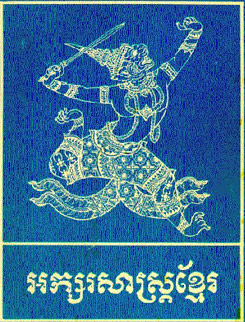 A testimony of the antiquity of the Khmer language are the multitude of epigraphic inscriptions on stone. The first written proof that has allowed the history of the Khmer Kingdom to be reconstructed are those inscriptions. These writings on columns, stelae and walls throw light on the royal lineages, religious edicts, territorial conquests and internal organization of the kingdom.
A testimony of the antiquity of the Khmer language are the multitude of epigraphic inscriptions on stone. The first written proof that has allowed the history of the Khmer Kingdom to be reconstructed are those inscriptions. These writings on columns, stelae and walls throw light on the royal lineages, religious edicts, territorial conquests and internal organization of the kingdom.Shadow Theatre
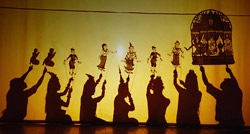 Nang sbek (shadow theatre) (or Lkhaon Nang Sbek) is closely related to the Nang Yai of Thailand, Wayang of Malaysia and Indonesia like the Islands of Java and Bali, thus implying that nang sbek may have came from an Indonesian or Malaysian origin from many centuries ago. Nang sbek is also a dying art form and may disappear because of the decline in popularity over the years with the introduction of modern entertainment. Before the spread of modern technology such as movies, videos and television the Khmers enjoyed and watch shadow theatre apart from the other sources of entertainment available around during that time. There are three kinds of shadow theatre in Cambodia:
Nang sbek (shadow theatre) (or Lkhaon Nang Sbek) is closely related to the Nang Yai of Thailand, Wayang of Malaysia and Indonesia like the Islands of Java and Bali, thus implying that nang sbek may have came from an Indonesian or Malaysian origin from many centuries ago. Nang sbek is also a dying art form and may disappear because of the decline in popularity over the years with the introduction of modern entertainment. Before the spread of modern technology such as movies, videos and television the Khmers enjoyed and watch shadow theatre apart from the other sources of entertainment available around during that time. There are three kinds of shadow theatre in Cambodia:- Nang sbek thom is an art that involves mime, song, music and having to dance as well as narration to the accompaniment of the Pinpeat orchestra.It is mainly features the Reamker.
- Nang sbek toch also called nang kalun and sometimes called ayang (small shadow theatre) uses smaller puppets and a wide range of stories.
- Sbek paor (coloured puppet theatre) uses colored leather puppets.
Sports
Cambodia has increasingly become involved in sports over the last 30 years. Football is popular as are martial arts, including Bokator, Pradal Serey (Khmer kick boxing) and Khmer traditional wrestling.
Bokator is an ancient Khmer martial art said to be the predecessor of all Southeast Asian kickboxing styles. Depicted in bas reliefs at Angkor Wat, Bokator was the close quarter combat system used by the ancient Angkor army. Unlike kick boxing, which is a sport fighting art, Boxkator was a soldier’s art, designed to be used on the battlefield. When fighting, Bokator practitioners still wear the uniforms of ancient Khmer armies. A kroma (scarf) is folded around their waist and blue and red silk cords are tied around the combatant's head and biceps.
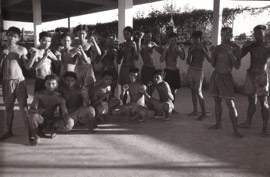 |
|
Young Cambodian boxers
|
Young Cambodian boxers
Pradal Serey, or traditional Khmer boxing, is a popular sport in Cambodia. Victory is by knockout or by judge's decision. Styles of boxing have been practiced in Southeast Asia since ancient times. In the Angkor era, both armed and unarmed martial arts were practiced by the Khmers. Evidence shows that a style resembling Pradal Serey existed around the 9th century. There have been heated debates between nations about the true origins of South East Asian kickboxing.
Khmer traditional wrestling is yet another popular Cambodian sport. Wrestling match consists of three rounds, which may be won by forcing an opponent to his back. Traditional matches are held during the Khmer New Year and other Cambodian holidays.
The Cambodian Football Federation is the governing body of football in Cambodia, controlling the Cambodian national team. It was founded in 1933, and has been a member of FIFA since 1953 and the Asian Football Confederation since 1957.
Phnom Pehn National Olympic Stadium is the national stadium with a capacity of 50,000 in Phnom Pehn.



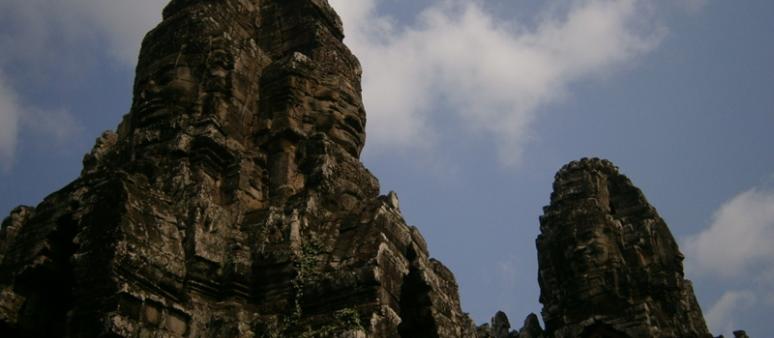
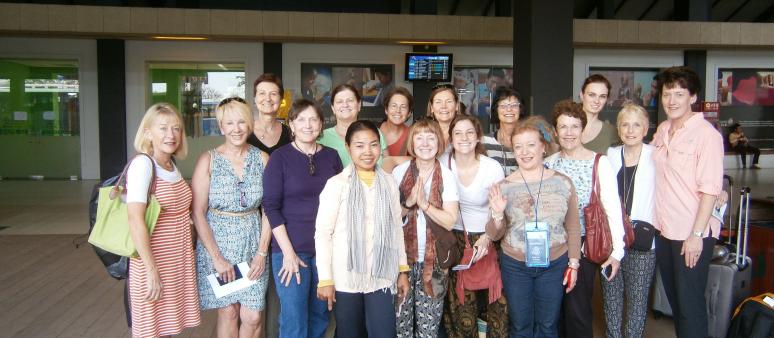
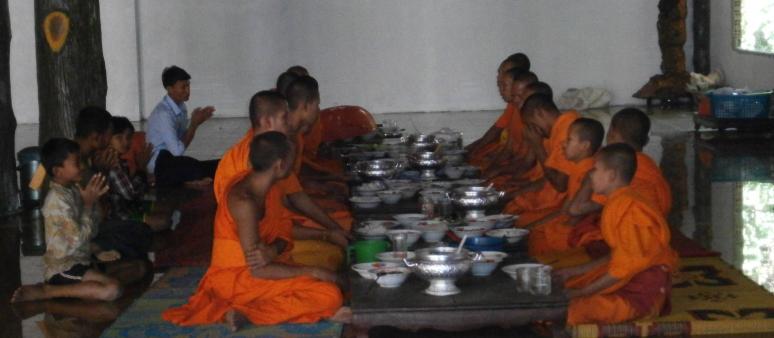
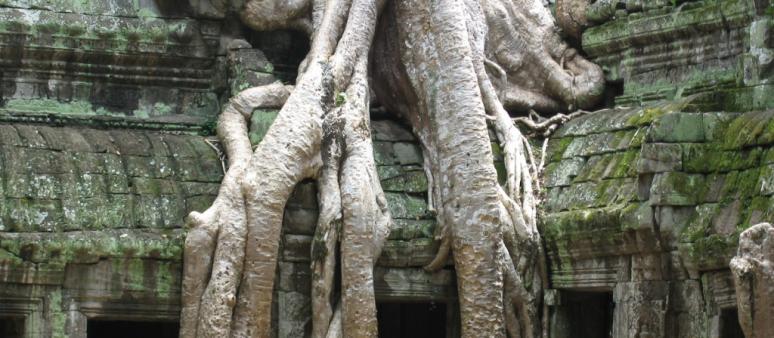
.jpg)

